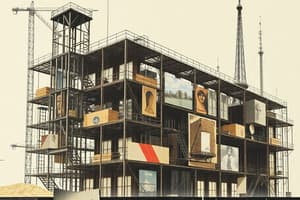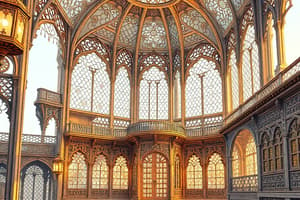Podcast
Questions and Answers
What is the primary function of a beam and column system?
What is the primary function of a beam and column system?
To support loads and resist external forces
How does an arch system distribute loads?
How does an arch system distribute loads?
Through curved arches
What type of structural system uses cables and towers to support loads?
What type of structural system uses cables and towers to support loads?
Cable-stayed system
What is the primary function of a dome system?
What is the primary function of a dome system?
What is the difference between a beam and a column?
What is the difference between a beam and a column?
What is an example of a truss?
What is an example of a truss?
What is dead load?
What is dead load?
What is the primary difference between live load and wind load?
What is the primary difference between live load and wind load?
What is the primary function of structural response?
What is the primary function of structural response?
What are the primary characteristics of concrete as a structural material?
What are the primary characteristics of concrete as a structural material?
Flashcards are hidden until you start studying
Study Notes
Structural Systems
Types of Structural Systems
- Beam and Column System: Consists of horizontal beams and vertical columns that support loads and resist external forces.
- Arch System: Uses curved arches to distribute loads and provide structural support.
- Dome System: A three-dimensional structure composed of arches that provide structural support and distribute loads.
- Frame System: A three-dimensional structure composed of beams and columns that provide structural support and resist external forces.
- Cable-Stayed System: Uses cables and towers to support loads and provide structural support.
- Suspended System: Uses cables and a tensioned structure to support loads and provide structural support.
Structural Elements
- Beams: Horizontal or sloping elements that resist loads and support weights.
- Columns: Vertical elements that support loads and resist external forces.
- Arches: Curved structures that distribute loads and provide structural support.
- Domes: Three-dimensional structures composed of arches that provide structural support and distribute loads.
- Trusses: Triangular structures composed of beams and connections that provide structural support and resist external forces.
Load Types and Structural Response
- Dead Load: The weight of the building itself, including materials and permanent fixtures.
- Live Load: The weight of occupants, furniture, and other temporary loads.
- Wind Load: The force exerted by wind on the building.
- Seismic Load: The force exerted by earthquakes on the building.
- Structural Response: The way a building responds to external loads, including deflection, stress, and strain.
Structural Materials
- Concrete: A composite material made from cement, water, and aggregate that provides strength and durability.
- Steel: A strong and flexible metal that provides strength and support.
- Wood: A natural material that provides strength and support, often used in beam and column systems.
- Masonry: A structure composed of blocks or bricks that provides strength and support.
- Composites: A combination of materials that provides strength and support, often used in modern buildings.
Structural Systems
Types of Structural Systems
- Beam and column system provides structural support and resists external forces through horizontal beams and vertical columns.
- Arch system distributes loads and provides structural support using curved arches.
- Dome system is a three-dimensional structure composed of arches, providing structural support and distributing loads.
- Frame system is a three-dimensional structure composed of beams and columns, providing structural support and resisting external forces.
- Cable-stayed system supports loads and provides structural support using cables and towers.
- Suspended system supports loads and provides structural support using cables and a tensioned structure.
Structural Elements
- Beams are horizontal or sloping elements that resist loads and support weights.
- Columns are vertical elements that support loads and resist external forces.
- Arches are curved structures that distribute loads and provide structural support.
- Domes are three-dimensional structures composed of arches, providing structural support and distributing loads.
- Trusses are triangular structures composed of beams and connections, providing structural support and resisting external forces.
Load Types and Structural Response
- Dead load is the weight of the building itself, including materials and permanent fixtures.
- Live load is the weight of occupants, furniture, and other temporary loads.
- Wind load is the force exerted by wind on the building.
- Seismic load is the force exerted by earthquakes on the building.
- Structural response is the way a building responds to external loads, including deflection, stress, and strain.
Structural Materials
- Concrete is a composite material made from cement, water, and aggregate, providing strength and durability.
- Steel is a strong and flexible metal that provides strength and support.
- Wood is a natural material that provides strength and support, often used in beam and column systems.
- Masonry is a structure composed of blocks or bricks that provides strength and support.
- Composites are a combination of materials that provides strength and support, often used in modern buildings.
Studying That Suits You
Use AI to generate personalized quizzes and flashcards to suit your learning preferences.




